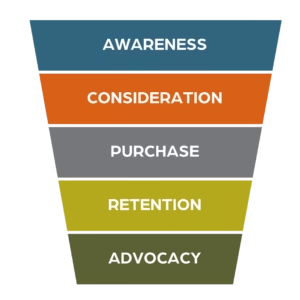Below we will review some of the factors driving these changes. And the reasons why we believe the ROAS model is no longer an accurate or comprehensive measurement of advertising success.
The pandemic and post-pandemic years dramatically sped up the adoption of e-commerce, mobile apps, social commerce, and digital payment systems. Consumers now expect instant, personalized, and seamless experiences. Additionally, AI-powered platforms like TikTok’s algorithm, Amazon’s recommendations, Google’s AI search results are constantly raising the bar. This makes marketing less about one-off conversions and more about long-term customer experience and loyalty.

Not a Linear Path to Purchase
Today’s consumers shop over a period of time—different days, different devices. Their journey is no longer a straight line. Between switching devices, platforms, and the time passed between seeing the first initial ad and completing the sale, their path to purchase is much more zig and zag. Seeing a Facebook ad might spark curiosity but few consumers purchase immediately. Often, the completion happens later, on a desktop computer or even in-store. Consumers shop while in line for coffee, in between meetings, at a red light, or late at night. Buying decisions are stretched across hours, or sometimes even days or weeks. In fact, 90% of consumers switch between multiple devices during their purchase journey, highlighting the importance of multi-channel strategies.1 Consequently, performance must measure this multi-channel influence, not just direct 1:1 conversion.
Shift in Consumer Trust & Buying Motivations
Shoppers are more skeptical of traditional advertising and instead lean on reviews, peer influence, influencers, and communities. Values-based purchasing is rising — sustainability, transparency, and authenticity affect brand choices as much as price or convenience. This alters purchase behavior shifting impulse buying to more “considered” purchases, and stronger loyalty to brands that align with personal values.
Delayed Decision Making
Factors like price sensitivity, bad timing, open questions, and the desire to physically try on or see the product all contribute to delayed purchasing. So much information can be overwhelming. What reviews can be trusted and what websites aren’t scams? ROAS ignores the “research” phase. Consumers go on a long journey because they research, they compare, and then they wait.
ROAS puts all its weight on the final click.
Arguably the most important factor to shift to a more modern success metric, is that the traditional 1:1 ROAS model gives all the credit to the final click. The sometimes dozens of in-between touchpoints from awareness to conversion don’t get any of the credit they deserve. There are lots of steppingstones for the consumer to get to the point of purchase whether it be exposure to earlier ads, an email, an influencer’s content, or a referral from a coworker, etc. The early moments of influence get ignored in ROAS. But all the touchpoints play a role and work together like a team. In ROAS-driven reports, the “journey” is invisible, but in the customer’s mind, the path they took was essential in their decision making.
Traditional ROAS is calculated like this:

- Revenue Attributed to Advertising = total sales revenue directly attributed to an ad campaign (based on the chosen attribution model, often the last click). Generally referred to as Last Click Attribution.
- Ad Spend = total money spent on that ad campaign.
Every Touchpoint Matters
Marketing is like a relay race. The baton passes from an advertisement to a mention to an email to a TikTok—building momentum as the impressions stack on top of one another—with the combination and timing instrumental in securing the purchase. From the ad to the email, to the influencer, to the video—it all counts. Together, these brand impressions and messages stick, driving the consumer to return to complete the purchase in the future, even though the touches may not convert immediately.
 Stages of the Customer Journey
Stages of the Customer Journey
The ROAS metric only acknowledges the purchase stage—even though consumers bounce around unpredictably within the sales funnel before making a decision. That being said, most brand building and trust actually occur during the awareness and consideration phases. These are the early stages of prospective customers receiving information through word of mouth, social media, email, advertisements, or even podcasts. The next phase is customers showing interest or consideration of purchasing the product or service. This is often where the consumer goes in circles—revisiting websites, watching videos, reading reviews, comparing prices, and asking peers. They can be stuck in this part of the funnel for days or even weeks. All the while, they are likely exposed to additional brand impressions. Eventually, the consumer gets to the purchase stage. After numerous clicks, views, conversations, and thoughts, the consumer chooses to buy or abandon the process. The traditional ROAS metric gives conversion credit to whichever “touchpoint” garnered the final click. But, as we all know, that final action is often a small stepping stone in their path to purchase.
Consider traditional ROAS only as a baseline.
ROAS is not useless—it’s simply incomplete. It will still serve as a good baseline metric. Whether testing a new campaign or understanding which channels are grasping the consumer’s attention within the final moments of conversion, ROAS serves its purpose, but there is more underlying information within the journey.
Transitioning to a blended ROAS model.
We recommend the transition to a more modern blended ROAS metric that considers the full impact of all brand impressions vs. all revenue generated. This approach calculates the combined costs of organic, paid, influencer, affiliate, and more against the total marketing spend. While the traditional ROAS model still remains a common metric, despite its flaws, studies show that 75% of businesses are now leveraging more up-to-date, multi-touch attribution models to gain a more detailed and accurate view of performance.2
Blended ROAS is calculated like this:

Key Differences Between Traditional & Blended ROAS:
- Numerator (Revenue): All revenue within the reporting period, not just what’s attributed to a single channel/campaign.
- Denominator (Spend): All ad and marketing spend (paid search, paid social, programmatic, display, video, even brand awareness campaigns).
With the impact that AI advancements are having on SEO and digital advertising, and traditional tactics, like direct mail, driving website visits that trigger the delivery of retargeting display ads—just to point out a couple top-of-mind connected actions—the old-school 1:1 marketing performance metric is simply short-sighted. And the old math just not telling the whole story anymore.
In summary, the rapid changes in consumer behavior are driven by digital acceleration, AI integrations, values-based decision-making, and fractured buying journeys. Because of this, the traditional measurement method is missing the full impact of impressions made along the comprehensive path-to-purchase. Forward-looking marketers, like our team at Acorn Marketing, are shifting toward Blended ROAS to ensure the inclusion of all touchpoints across the entire journey, incremental lifts in conversions, and holistic ROI to measure success in today’s environment. Interested in help auditing your current marketing performance? Let’s chat.

Sources:
1. WIFITalents Reports, Multi Channel Marketing Statistics, June 1, 2025.
2. Arma & Elma, Top Attribution Marketing Statistics 2025.





